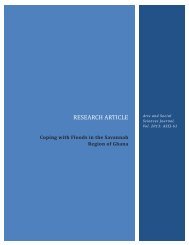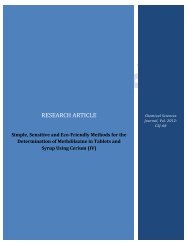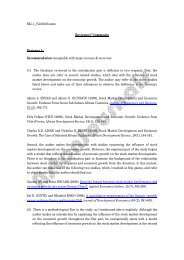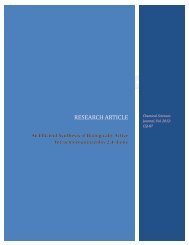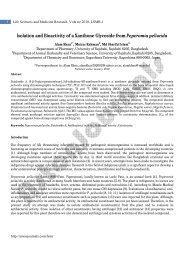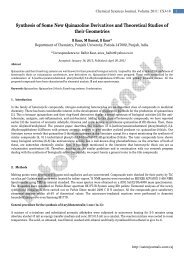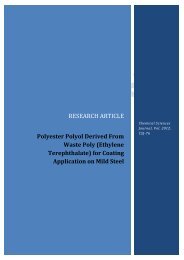Rapid and Sensitive Spectrophotometric ... - AstonJournals
Rapid and Sensitive Spectrophotometric ... - AstonJournals
Rapid and Sensitive Spectrophotometric ... - AstonJournals
Create successful ePaper yourself
Turn your PDF publications into a flip-book with our unique Google optimized e-Paper software.
Chemical Sciences Journal, Vol. 2012: CSJ-80<br />
5<br />
To the 20 mg of the placebo blank, 11.4 mg of PPH was added <strong>and</strong> homogenized. The solution of the<br />
synthetic mixture equivalent to 100 μg ml - 1 of PPL was prepared as described earlier. The resulting solution was<br />
assayed (n = 5) by all the three methods after appropriate dilution.<br />
2.5.6 Procedure for spiked human urine<br />
Five ml of PPH free urine taken in a 125 ml separating funnel was spiked with 20 ml of aqueous solution containing<br />
11.4 mg of pure PPH <strong>and</strong> to the same solution, 5ml of liquid ammonia was added followed by 20 ml of ethyl<br />
acetate. The content was shaken for 15 min. The lower aqueous layer was discarded <strong>and</strong> the upper organic layer<br />
was collected in a beaker containing anhydrous sodium sulphate. The water-free organic layer was transferred into<br />
a dried beaker <strong>and</strong> evaporated on a hot water bath. The dry residue was dissolved in dichloromethane in a 100 ml<br />
calibrated flask, <strong>and</strong> diluted to the mark with solvent. This solution was diluted appropriately with<br />
dichloromethane to get working concentrations. An aliquot of resulting solution was analyzed following the<br />
procedures described above.<br />
2.5.7 Procedure for stoichiometric relationship<br />
Job’s method of continuous variations of equimolar solutions was employed: 5.78 × 10 -5 M each of PPL <strong>and</strong> BTB in<br />
dichloromethane (Method A) solutions, 5.78 × 10 -5 M each of PPL <strong>and</strong> BCG in dichloromethane (Method B)<br />
solutions <strong>and</strong> 1.93 × 10 -4 M each of PPL <strong>and</strong> BCP in dichloromethane (Method C) solutions were prepared<br />
separately. A series of solutions was prepared in which the total volume of PPL <strong>and</strong> dye was kept at 5 ml. The drug<br />
<strong>and</strong> reagent were mixed in various complementary proportions (0:5, 1:4, 2:3, …..5:0, inclusive) <strong>and</strong> completed as<br />
directed under the recommended procedures. The absorbance of the resultant ion-pair complex was measured at<br />
420 nm in method A <strong>and</strong> C, <strong>and</strong> 425 nm in method B.<br />
3. Results <strong>and</strong> Discussion<br />
The mechanism for the extraction-free ion pair complex formation between nitrogenous compound <strong>and</strong><br />
sulphonphthalein acid dyes were recently reported [35-37]. Similar reaction mechanism (Scheme 1) for ion pair<br />
complex formation between PPL <strong>and</strong> BTB, BCG or BCP is proposed. The PPH contains a secondary aliphatic amino<br />
group which forms ion-pair complex with sulphonphthalein acid dyes, BTB, BCG <strong>and</strong> BCP. Since ion-pair complex<br />
forms in non-polar solvents, the insolubility of PPH in any of the non-polar solvents was overcome by using PPH in<br />
its base form, PPL.<br />
The dyes employed have insignificant absorbance (Figure 2). The formation of intense yellow colored<br />
product with an absorption maximum at 425 or 420 nm is due to an opening of lactoid ring <strong>and</strong> subsequent<br />
formation of quinoid group [38]. It is supposed that the two tautomers are present in equilibrium but due to strong<br />
acidic nature of the sulphonic acid group, the quinoid moiety must predominate.<br />
3.1 Optimization of experimental variables<br />
3.1.1 Absorption spectra<br />
The absorption spectra of the ion-pair complexes, formed between PPL <strong>and</strong> each of BTB BCG <strong>and</strong> BCP, were<br />
recorded at 370-540 nm against respective reagent blank <strong>and</strong> the same are shown in Figure 2. The yellow ion-pair<br />
complexes showed maximum absorbance at 420 nm for PPL-BTB <strong>and</strong> PPL-BCG, <strong>and</strong> 425 nm for PPL-BCP (Figure 2).<br />
The measurements were thus made at these wavelengths.<br />
3.1.2 Effect of solvents<br />
The organic solvent exhibiting minimum blank absorbance in the presence of sulphonphthalein dyes alone is the<br />
ideal solvent for extraction-free ion pair technique. In order to select a suitable solvent for preparation of the<br />
reagent solutions used in the study, the reagents were prepared separately in different solvents such as 1,4-<br />
dioxane, chloroform, acetonitrile, acetone <strong>and</strong> dichloromethane, <strong>and</strong> the reaction of PPL with BTB, BCG or BCP was<br />
followed. Among the organic solvents studied (Figure 3), the order of blank absorbance for all the dyes was:<br />
dichloromethane



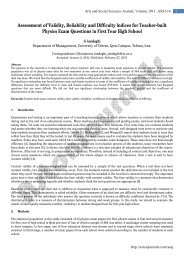
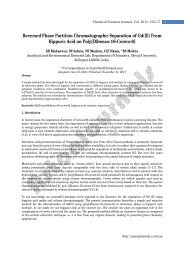
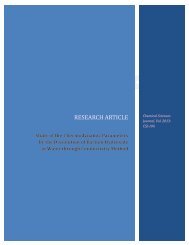
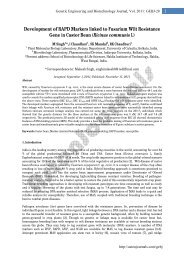

![[1,4]-benzodiazepine-2-one Derivatives as Potent - AstonJournals](https://img.yumpu.com/49117784/1/184x260/14-benzodiazepine-2-one-derivatives-as-potent-astonjournals.jpg?quality=85)
